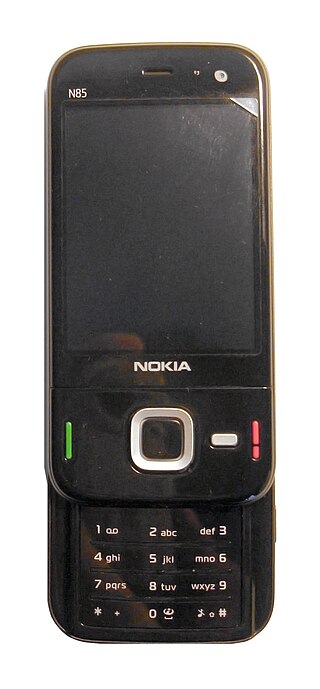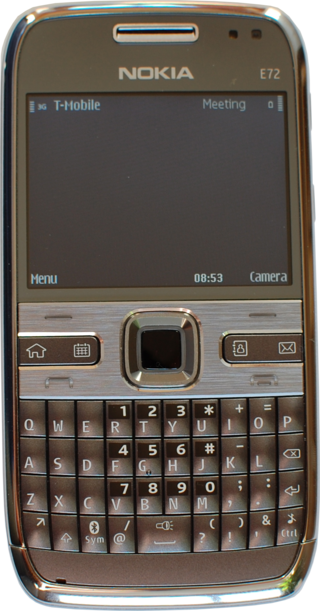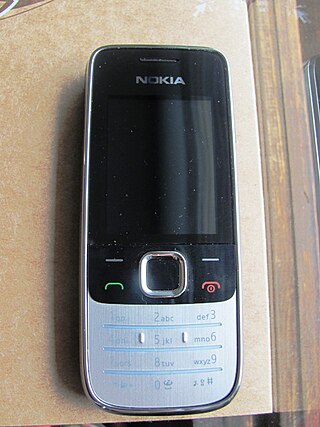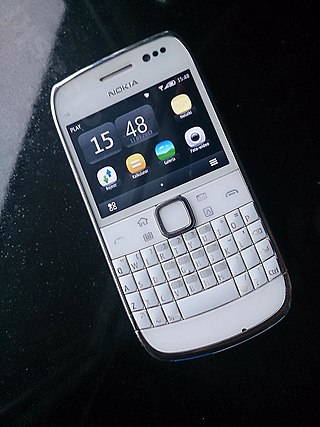
The Nokia 6230 is a mobile phone based on the Nokia Series 40 platform. It was announced on 28 October 2003 and released in February 2004.

The Nokia 9210 Communicator is a third-generation Communicator series mobile phone produced by Nokia, announced on 21 November 2000 and released in June 2001. It greatly improved on the second generation Nokia 9110 Communicator, providing a colour main screen and using an ARM processor. It is one of the few mobile phones able to send and receive fax.

The Nokia 3250 is a mobile phone running Symbian OS v9.1, announced on 26 September 2005. It features a unique 'twist' design that transforms the traditional phone keypad into a camera and dedicated music control keys. It was marketed as a music phone and can store up to 2 gigabytes of music and other data thanks to a microSD memory card slot, and features a two-megapixel camera as well as other smartphone capabilities.

The Nokia Eseries consists of business-oriented smartphones running Symbian OS, with emphasis on enhanced connectivity and support for corporate e-mail push services, as well as enterprise-styled products and many featuring QWERTY keyboards. All devices have advanced office features through its S60 platform. Phones equipped with Wireless LAN also provide a VoIP client. Throughout the series' lifetime its main competitors were BlackBerry products from Research In Motion. The Eseries was marketed until 2011.

The Nokia N95 is a mobile phone produced by Nokia as part of their Nseries line of portable devices. Announced in September 2006, it was released to the market in March 2007. The N95 ran S60 3rd Edition, on Symbian OS v9.2. It has a two-way sliding mechanism, which can be used to access either media playback buttons or a numeric keypad. It was first released in silver and later on in black, with limited edition quantities in gold and purple. The launch price of the N95 was around €550.

The Nokia N73 is a smartphone announced by Nokia on 2006 as part of the Nseries and started shipping on 15 July. The N73 succeeded the N70 and packed in numerous multimedia features. It features a 3.2 megapixel autofocus camera, a front camera, a then-large 2.4-inch display, and stereo speakers, all in a relatively slim and pocketable size and form. It runs on Symbian v9.1. An improved, music-focused version called N73 Music Edition was released in 2007.

The HTC Excalibur (HTC S620) is a smartphone model manufactured by High Tech Computer beginning in 2006. It is rebranded and sold as the O2 Xda Cosmo, the T-Mobile Dash, the HTC S621 for Rogers Wireless in Canada, the HTC S621 for Suncom Wireless in the lower-eastern United States, the BT ToGo (as part of the BT Total Broadband Anywhere package), and the Dopod C720W. The model has been discontinued.

The Nokia 6120 classic is a mid-range smartphone from Nokia that was announced on 17 April 2007. It runs on Symbian v9.2 with a S60 3rd Edition FP1 user interface.
The Nokia 6000 series or Classic Business series is range of mobile phones marketed by Nokia. This family of phones is notable for their conservative, unisex designs, making them popular with business users.

Nokia E51 is a Symbian OS mobile phone by Nokia announced on 18 September 2007 as the replacement of the Nokia E50 in the business-focused Eseries line. It was the second Nokia UMTS / HSDPA dual band device. The phone was available with a black, silver or bronze-coloured border and backplate. It has a slim body made of stainless steel, and was the smallest Nokia smartphone of the time, yet is still technologically capable like other S60 devices of the time. A version without the integrated camera also existed. The E51 was highly acclaimed and was succeeded by the Nokia E52.

The Nokia E71 is a smartphone introduced on 8 May 2008 from the Eseries range with a QWERTY keyboard targeting business users worldwide. It runs on Symbian OS v9.2, with a Series 60 3rd Edition, second generation Feature Pack 1. The Nokia E71 succeeded the Nokia E61/61i models, building on the base design and form factor but enhancing on the feature set.

The Nokia E66 is a slider mobile phone in the Nokia Eseries range, a S60 platform third edition device with slide action targeting business users. It is a successor to the Nokia E65 with which it shares many features.

The Nokia N85 is a smartphone produced by Nokia, announced on 27 August 2008 as part of the Nseries line. The N85 runs on Symbian OS v9.3 with S60 3rd Edition platform with Feature Pack 2. It was released in October, retailing for 450 euros before taxes.

The Nokia E72 is a smartphone from the Nokia Eseries range manufactured in Finland. The Nokia E72 was announced on June 15, 2009 at the Nokia Connections 2009 event in Singapore. It is the successor to the Nokia E71 and is based on a similar design and form factor, and offers a similar feature set. The Nokia E72 is a business-oriented phone and has standard features including mobile email, calendar and instant messaging among many others with its Symbian-based S60 3rd Edition Feature Pack 2 operating system.

The Nokia 2730 classic is a Nokia Quad-band GSM/UMTS 3G cell phone that includes a camera, FM radio, Bluetooth, music and video player, as well as several internet-based applications.

Stonestreet One was a software company specializing in Bluetooth software solutions. Founded in 1999 in Louisville, Kentucky, Stonestreet One created and sold software for the Bluetooth wireless technology industry. They specialized in solutions for chipmakers, distributors, embedded software companies and Original Equipment Manufacturers. Stonestreet One was acquired by Qualcomm in 2014.

The Nokia N8 is a touchscreen-based smartphone developed by Nokia. Announced on 27 April 2010, the Nokia N8 was the first device to run on the Symbian^3 mobile operating system and it was the company's flagship device for the year. It was released on 30 September 2010 at the Nokia Online Store before being released in markets around the world on 1 October 2010. There were two version made, the N8 and the N8-00. The N8 was made for Vodafone and locked to its networks, and the N8-00 was made by Microsoft and open network.

The Nokia E6-00 is a smartphone running the Symbian^3 operating system. It supersedes the Nokia E72 as the new Symbian business mobility solution from Nokia following its announcement on 12 April 2011. It shipped with the new "Symbian Anna" version of Symbian^3, and originally retailed for 340 euros before taxes.
Nokia's strategic nomenclature can be traced back in 2005 when the Nseries line was launched, offering devices with flagship specifications and premium hardware at various price points. These devices were considered the "bread and butter" of the company and were often positioned to showcase their latest technologies. Thanks to the newfound consumer and enterprise interest in smartphones at the time, the company introduced four additional collections to diversify their product portfolio and meet demands in most market segments. These new phone series were named Eseries, targeting small business and enterprise customers; Xseries, providing consumer-grade multimedia-focused devices; Cseries, which Nokia used to target both the low-end and mid-range market segments; and Tseries, for devices exclusive to the Chinese market.



















